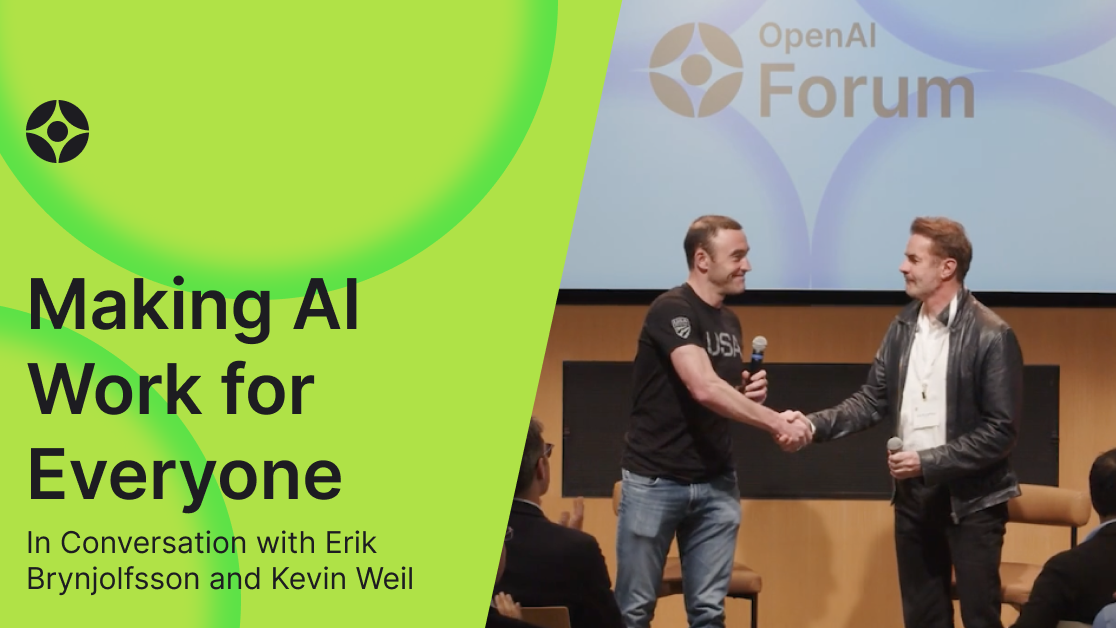Making AI Work For Everyone

A Conversation with OpenAI’s Kevin Weil and Stanford Economist Erik Brynjolfsson
April 8, 2025

Earlier this year, the OpenAI Forum hosted a fireside chat on the economic implications of artificial intelligence with Kevin Weil, Chief Product Officer at OpenAI, and Erik Brynjolfsson, a Stanford University professor who studies the digital economy. They discussed how AI compares to past technological revolutions, why its benefits aren’t fully reflected in traditional metrics, and how to integrate AI so that it augments human workers rather than replacing them.
Major innovations can take years to boost productivity – not because of the technology itself, but because companies are sometimes slow to adopt and integrate it. The process of electrification over a century ago offers a vivid example:
Erik Brynjolfsson:
They actually put machines in the factories and still didn’t get real productivity gains. It wasn’t the physical installation so much. Initially they took out a steam engine and put in a big electric motor where the steam engine was, and nothing much changed — there was no big productivity gain. It literally took 30 years for a generation of managers to retire before they realized: Wait, we don’t need one big motor with pulleys and belts. We could give each machine its own electric motor, lay out the factory on one floor based on workflow, and have an assembly line. That led to productivity doubling or tripling. So the delay was more about reorganizing and re-skilling — the intangibles — rather than just building infrastructure.
History also suggests that initial investments in process changes eventually lead to big payoffs once the technology is fully leveraged.
Erik Brynjolfsson:
These general-purpose technologies have what we sometimes call the productivity J-curve. Initially, you have to invest a lot in re-skilling, changing your business processes, and figuring out better ways to use the tech. All those costs don’t translate into benefits immediately, but when they do, you get a real takeoff. I think we still haven’t finished all that reorganization. The good news is it’s happening a lot quicker this time.
Throughout history, technology has mainly complemented human labor – and if we steer AI in that direction, it can boost productivity and wages instead of undermining them:
Erik Brynjolfsson:
The value of an hour of human labor used to be very low, and it’s been going up and up. Why? Because we have more and better tools that make each hour more valuable. Those tools largely enhanced what workers can do. Now, one concern is that AI is starting to become a closer and closer substitute for human work in some areas. Maybe eventually that substitution is inevitable in certain tasks, but there’s plenty of room to direct AI to complement humans instead – to do things that augment human capabilities. There are policy choices, in how we design AI, in education and taxes and other areas, that can steer it more toward being a tool that makes people more productive, rather than a replacement. If we do that, we’re more likely to see broad-based prosperity from AI.
Measuring AI’s economic impact isn’t straightforward, especially when many AI services, like other digital offerings, are offered to users for free. There needs to be a better approach.
Erik Brynjolfsson:
We introduced a tool called GDP-B – the B stands for benefits rather than costs. Free tools like ChatGPT or Wikipedia create a lot of value for people, but that’s not captured in existing GDP statistics. So we run experiments asking people how much we’d have to pay them to stop using a service for a while. That lets us estimate the consumer surplus — basically, how much benefit those tools provide. We can put those alongside the GDP numbers to see not just where money is spent, but where we’re getting value. It will lead to a metric that is suitable for the digital economy similar to what GDP was for the previous economy.
Even the best AI won’t help if people can’t trust it. In a recent study, a doctor paired with an AI assistant actually performed worse than the AI alone, all because the doctor couldn’t tell when to trust the AI’s advice. It’s a cautionary tale underscoring why interpretability and transparency are crucial for human-AI collaboration.
Erik Brynjolfsson:
They tried three approaches: human-only, AI-only, and a human doctor with AI. You’d hope the doctor-plus-AI team would do best, but it actually did worse than the AI alone. The big reason is that current AI systems aren’t very interpretable, so the doctor didn’t know when to trust the AI or override it and ended up making the wrong calls. If we want humans and machines working together successfully, people need to be able to trust the AI and know when to rely on it.
Nimble startups adopting AI quickly could disrupt slower incumbents – in effect, sparking a new wave of accelerated innovation:
Kevin Weil:
They could make the cycle go faster because they’re able to punch above their weight class in a way that maybe was harder in previous eras.
That process could accelerate as AI becomes exponentially cheaper to use, which opens the door to much wider adoption.
Kevin Weil:
Sam Altman has said if you look at the cost for a particular level of intelligence, suitably defined, it's coming down by a factor of 10 every year at the rate that we're going. And, you know, you think about Moore's Law, that was twice the number of transistors on a chip every 18 months. This is 10x a decrease in cost every year. So it's a much, much steeper exponential, which is pretty amazing. So we're, obviously, the models are getting smarter at a rapid clip, so they're getting smarter and they're getting cheaper.
But we know that no matter how successful we are, we can only build a tiny fraction of all the possible applications of AI. So with our API, we’re trying to get AI out to the world as cheaply as possible. Every time we make the technology more efficient or get the same level of intelligence at a lower cost, we pass those savings straight back to developers. That’s why we believe in the API approach.
AI could also help address a worrisome shift. Business dynamism in the U.S. has declined over the past few decades, with startup formation and worker mobility both on the downturn. AI has the potential to help turn that around.
Erik Brynjolfsson:
America has never been successful by freezing in place. You’ve always got to embrace change. For new technologies to really take off, you need new companies, or at least new processes within existing companies, to emerge and push things forward. Lately that kind of dynamism hasn’t been happening as fast as it used to. If we want to speed up the payoff from AI, we need to speed up those kinds of changes across the economy.

